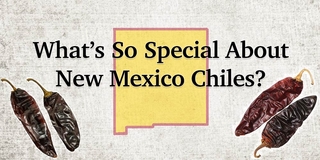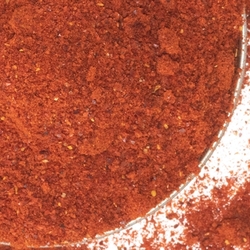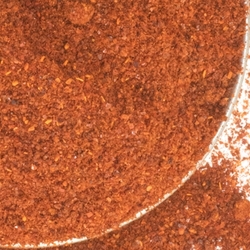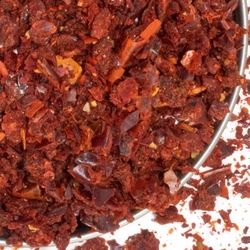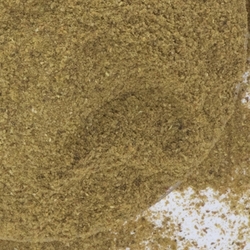What's So Special About New Mexico Chiles?
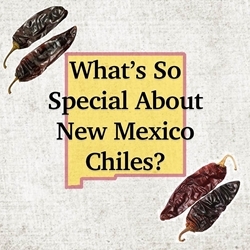
Chile peppers play an important role in the culture and development of the American Southwest, and have been embedded into the fabric of the Americas for thousands of years. According to the nonprofit organization Archaeology Southwest, chile peppers were one of the most vital foodstuffs among Mesoamerican societies stretching from central Mexico down into Central and South America. Contrary to widely-held belief, Hatch and New Mexico chile peppers are not indigenous to New Mexico. New Mexico's peppers migrate north from Mexico, where they are indigenous, which would be the next logical assumption. Instead, these cultivated peppers took the long way ‘round. A vast array of chile peppers were among the New World crops that made their way to Spain after the invasion of the conquistadors and the overthrow of Montezuma in the early 1500s. These peppers were then carried back across the ocean and introduced to New Mexico with the Spanish colonialization of the southwest; many food historians and anthropologists credit this introduction to Don Juan de Oñate, who, in 1598, became the first colonial governor of the newly-established colony of Santa Fe.
There is only one chile pepper with roots in the US, and that is the chiltepin, a small berry-like pepper with a searing heat which, according to Archaeology Southwest, could be found in parts of Arizona, New Mexico, Texas, and Northern Mexico prior to the arrival of the Spaniards. The Spaniards established many different varieties of chiles in the New World, like chilacas (or pasillas, when dried), jalapeños, poblanos (the dried version is ancho) and, serranos. But one variety adapted exceptionally well to New Mexico's climate and soil. It was a guajillo varietal, a long green chile that turned red in the fall. These chiles became part of the landscape of New Mexico, and were cultivated for hundreds of years with such meticulous care that multiple varieties emerged. These varieties became known as "landrace chiles".
More than anthropological supposition, there is DNA research conducted by the NMSU Chile Breeding Program that genetically ties many New Mexico landrace chiles, which had traveled across the ocean with the Spanish colonizers, to Mexican ancestry. Landrace chiles are so named because they have been selectively bred and managed by individual families in specific regions so much that they have begun to reflect their growing environment. Expressing themselves differently in manner of size, heat, flavor, thickness of skin, and so on, these peppers were designated as distinct "races", and are closely linked to specific land areas where they've been grown for hundreds of years. Landrace chiles are often named after the larger community where they're grown in, like the Chimayo and Espanola, but many family farms maintain their own uniquely named landrace chiles -- some of these include Hernandez, Escondida, Alcaldes and Velarde.
Northern landrace chiles tend to be smaller, skinnier and have square shoulders and a more twisted shape. The aroma is flowery, the flavor intense and the heat levels range from medium to hot. They also tend to be more difficult to skin than the commercial southern New Mexico varieties.
While the popularity of modern New Mexico chiles is without a doubt tied to Spanish colonization of the area, the real credit for its survival as a vital crop in the state can be traced to Native American populations that adopted them into their own agricultural and culinary repertoires. For the 300 years after Onate's introduction of chiles to New Mexico, other than with the Native Americans, they were barely recognized in the regional cuisine. Today chiles are coveted as New Mexico gold.
Table of Contents
The Academics of Chile Pepper Production
There's More Than One Way To Hatch A Chile
The Academics of Chile Pepper Production
In the late 1800s a pioneering horticulturist named Fabián Garcia, a graduate of New Mexico A&M (later New Mexico State University, NMSU) began working with local farmers to improve native chiles through selective breeding. His goal was to produce a milder chile cultivar that would appeal to the growing Anglo population, in turn strengthening local chile agribusiness. In 1921, the new chile pod that emerged triumphant was the 'New Mexico No. 9' which had loads of brisk flavor but minimal heat. This cultivar was important historically, not only because it was the first chile cultivar released from New Mexico A & M, but also because it introduced a new pod type --'New Mexican' -- to the world. The Chile Pepper Institute have carried this practice forward, with the research scientists working with local farmers to develop hardy new or improved pepper cultivars. For more than 100 years they have worked to develop peppers that reflect the sweep of the landscape and the cultural ideals of New Mexico chile growers, making them the longest-running pepper institute in the world.
There's More Than One Way To Hatch A Chile
According to Dave Dewitt, the noted chile historian, “There is no such thing as a Hatch chile, despite all the hype about them. It is not a chile variety, as many people think.
The New Mexico Hatch chile has a family farm image that can be traced back to the Franzoy family -- Austrian immigrants who arrived in the Hatch valley about 90 years ago. When the Franzoy family settled here, they purchased a plot of land and began farming, and chiles became a primary focus. Joseph and Celestina Franzoy had 10 children, who in turn produced 36 grandbabies between them, and so on. The Franzoys are now seeing their fifth generation in Hatch, and many of valley's current chile farmers are still Franzoys, either by name or by marriage. Early on, the family became very involved with New Mexico A & M (now NMSU), working closely with them in cultivating several successful varieties of chiles. The expanding family members bought up a lot of the farm land in the valley and today cultivates New Mexico chiles on thousands of acres of pristine farm land in the valley.
One example of this can be found in the "Big Jim" cultivar, developed in part by Jim Lytle, son-in-law of Joseph Franzoy, one of the first commercial farmers in the Hatch area. According to Jim Lytle's son, Jimmy, the first time his grandfather ate a chile was at a friend's house, and when that first burst of heat hit him, Joseph thought he'd been poisoned and told his wife Celestina to stop eating. Once they were assured that death was not imminent, the Franzoys acquired a taste for spicy food and Joseph started farming chiles commercially. Joseph's daughter June remembers watching her father launch his farm, just two acres to start, and grow it into a Hatch institution. June married Jim Lytle, who joined his father-in-law's business and began working with NMSU to develop his own cultivar. The Big Jim pepper, long, and crisp, and spicy with a slow-burning heat that builds, was released in 1975 and is still going strong. June, now June Rutherford, remarried after Jim's death in 1987, and son Jimmy manage the farm her father started.
Along with his son Faron, Jimmy Lytle then developed one of the hottest of the Hatch varieties, and gave the world the spicy burn of the Lumbre chile. Faron Lytle then developed the mild Giuzeppi chile cultivar and named it after their family patriarch, and this is the chile used in our New Mexico Chile Powder.
You can try the sweet, almost smoky burn of the ripe Big Jim pepper in our Hatch New Mexico Chile Flakes, and, unripened, as a component in our New Mexico Green Chile Powder. The green powder and flakes also incorporate the New Mexico 6-4 chile cultivar, to add uniform flavor to the crisp big-sky flavor of a still-green Big Jim. Any of these items would make a great addition to chilis, or would add southwestern flair to omelets or rice. You just need to decide if you want the earthy, raisiny flavor of the red chiles, or the bracing sass of the green. Lumbre Chile Powder is a welcome ingredient for traditional dishes like enchiladas or in salsas, but adventurous food explorers have but their fruity heat into cookies and ice cream.
While Lumbre packs the heat, Sandia New Mexico Chile Powder has a medium heat and more of a fruity flavor profile. They thrive across the various terrains of New Mexico, so they can range in their heat and sweetness, depending on their planting elevation and the day-to-night temperature changes. Try them in pozole, you won't regret it. Each of these items retains their own characteristics, and we feel that they showcase the astonishing breadth of New Mexico chiles. But are they terroir products?
What is Terroir?
"Terroir," says Dr. John Westbrook, Professor of French Studies at Bucknell University, "at its most basic, is the link between taste and place." It implies quality and an expected flavor profile, he continues, but doesn't necessarily guarantee it, because "being what they are, biodynamics can't guarantee consistency". What terroir does guarantee, he says, is that one product is different from another, because of the factors that combine to create it. Terroir helps establish the agricultural idea of identity. Referring to the French words for "territory" and "ground"—le territoire and la terre, respectively—terroir signifies the impact that land and environment can have on produce. But it also embraces the emotional connection people can have to their produce and the particular parcel of land that nurtured it. While Americans, according to Westbrook, may put primary value on their patch of land and the physical forces that have shaped it, with items like Hatch chiles, it's difficult to separate their physicality from their cultural importance.
Challenges Facing Hatch New Mexico Chile Farmers
In 1992, the year before the North American Free Trade Agreement (NAFTA) was approved there were approximately 35,000 acres dedicated to growing New Mexico chiles and by 2013 this was down to only 9,000 acres and according to the New Mexico Chile Association 2014’s harvest was the smallest in recent memory.
The passing of NAFTA started the decline as New Mexican chile farmers couldn't compete with chile producers from Mexico who paid lower wages for the labor intensive hand harvesting. To add more fuel to the fire even though Americans are consuming more chiles and spicier food than ever the state is facing increased competition not just from Mexico but also from China and India. New Mexico Business Weekly cited United States Department of Agriculture statistics several years ago which showed that US chile pepper imports soaring from 417 million pounds in 1999 to more than one billion pounds by 2008.
If that wasn’t enough New Mexico chile farmers are battling Mother Nature as the changing climate appears to be playing other tricks. During the last several years many growers have watched their green chiles mature to red much sooner than normal, which is causing problems in the harvest schedule.
More chiles are sold as Hatch New Mexico chiles than could possibly be grown in the small valley. In an effort to protect their chiles from counterfeiters trying to cash in on the reputation of New Mexico chiles, the New Mexico Chile Association launched a certification program in 2011 similar to other well-known product labels, such as "100% pure Florida" and "California olive oil."
Hatch Chiles Go to Court
Terroir products have to walk an interesting line. They are an organic expression of an area, and are as intimately tied to history and culture as they are to the land and environment. The celebration of their existence inhabits a narrow, localized view, as the community that brings forth terroir wines or vegetables or cheeses takes personal pride in what they've produced. But these products also have to find their place in a global scheme. Dr. Westbrook says that terroir "cannot exist without something else, similar, for it to be compared to." Had there been no other pepper with which to compare the Hatch chile, then it would still be a loved and adored product, but its cultural significance as a New Mexico pepper wouldn't matter.
There are similar examples in the US; Vidalia onions, for example, are trademarked and their growing area is relegated to specific counties in the state of Georgia. "Terroir doesn't have to be fancy, like cheese or wine," Westbrook says, "it can be anything that has cultural and historical significance. I think Pennsylvania's Lebanon bologna is a terroir food. What it does is specify a connection between food and place, and creates and protects a difference."
Thanks to a final court ruling on June 17, 2016, the provenance of Hatch New Mexico peppers has been determined to be relevant and protected. The Tenth Circuit US Court of Appeals (presided over by a panel of three judges, one of whom was current Supreme Court Justice Neil Gorsuch), decided that Hatch New Mexico peppers warrant legal trademark protections. The Circuit Court of Appeals ruled that only those peppers grown in the valley around Hatch, NM can be called Hatch chiles. If the seeds from a Hatch chile are grown elsewhere, it is a Hatch-style pepper, but it is not a trademarked Hatch chile.
The Pepper Wars
Further outside comparisons to Hatch chiles come from Pueblo, Colorado; growers there have begun promoting their peppers as contenders for the US pepper throne. Even Colorado's Governor Jared Polis has gotten involved, issuing sportsmanlike challenges to New Mexico Governor Michelle Lujan Grisham over whose pepper reigns supreme. The Pueblo Mirasol chiles, another cultivar developed from Anaheim peppers, have been grown in that region for a little over 100 years and have begun expressing their own characteristics. Proponents of the Colorado peppers say they are even meatier than Hatch chiles, and that the elevation they're grown in helps concentrate the capsaicin compound, so they're hotter, too. Pueblo chile growers have even formed their own association…and have filed a certification mark to denote and protect all peppers grown in the Pueblo area.

